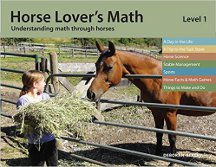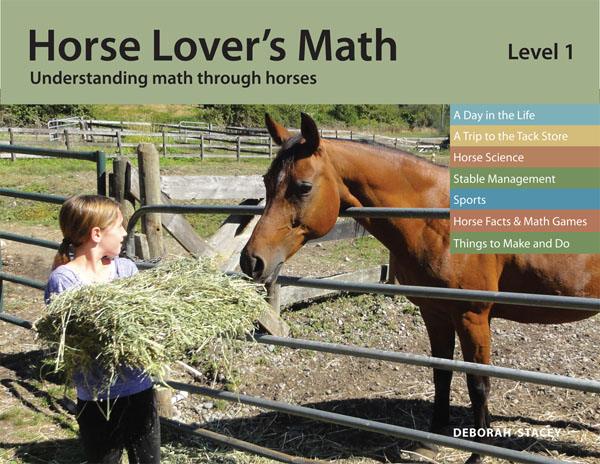Horse Lover’s Math: Understanding Math through Horses might be the perfect way to help a math-averse horse-loving girl grasp the importance and usefulness of math. This 175-page book should be ideal for girls in about fourth or fifth grade. The book teaches about horses as much or more than it teaches math applications, and it’s not just fluff. This is the real deal if a child wants to learn more about horses and their care, competitions, and equipment.
The book is presented in seven sections by horse-related topics rather than by math topics. Students practice various math skills having to do with measurement, addition, subtraction, multiplication, division, fractions, money (purchasing and budgeting), area, perimeter, time, and temperature. However, math skills are applied as they fit into the topics rather than in a progression of difficulty.
Some of the main topics covered in the book are participation in a schooling show, attending horse camp, grooming horses, riding clothes, a horse’s skeleton and conformation, calculating a horse’s height and weight, stable management and record keeping, show jumping, barrel racing, thoroughbred racing, and western trail class. There are many more facets covered, including a few make-and-do projects.
Horse Lover’s Math is designed for students to write their answers directly in the book for most responses, so you will need a copy for each student. The amount of math isn’t overwhelming. If a girl has not yet learned a particular math skill, it might be a good time to introduce it even if she doesn’t try to master it at that point. All of the math is applied through word problems and completion of charts and graphs.
Plentiful black-and-white photos and lovely, hand drawn illustrations are an important feature of the book since they show what is being discussed or are used for math applications.
Parents will appreciate the answer key at the back of the book as well as the summaries of key objectives taught in each section. The summaries might help parents easily document what has been learned.
Author Deborah Stacey lives in Canada, so she has produced two versions of the book: Canadian Metric or Imperial Version. The Imperial Version uses measurement and money systems familiar to homeschoolers in the U.S. The Amazon link below takes you to the Imperial Version even though there is nothing on the page to indicate this.
This book is labeled Level 1, so there might additional volumes in future.









